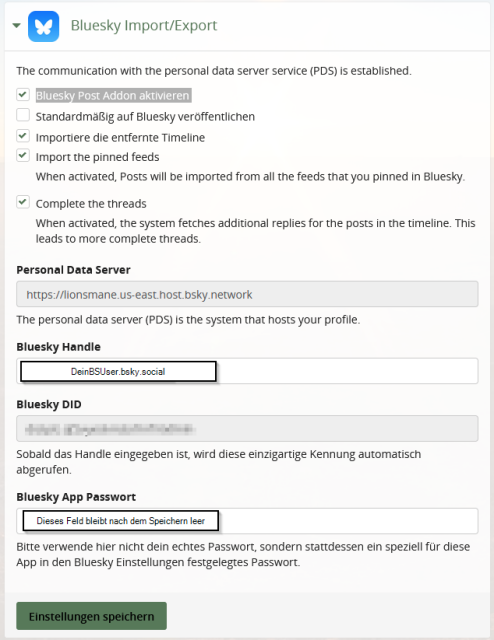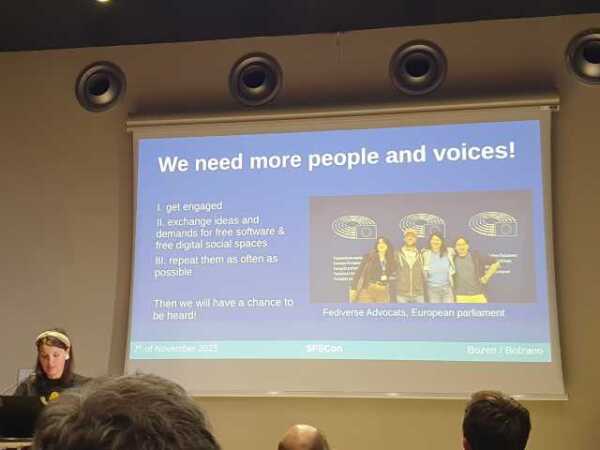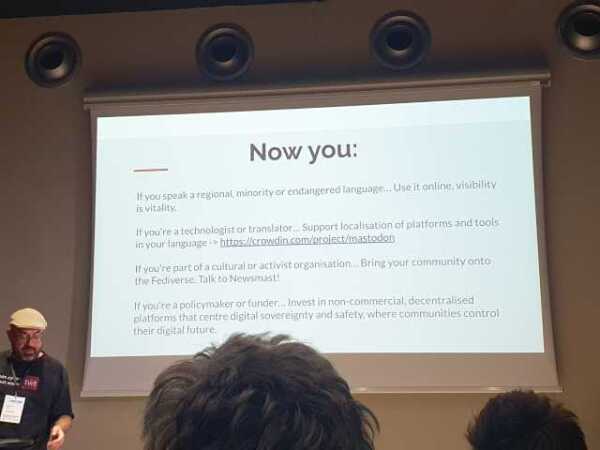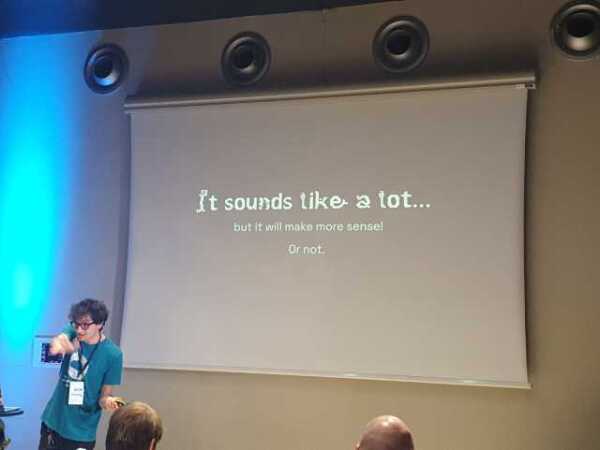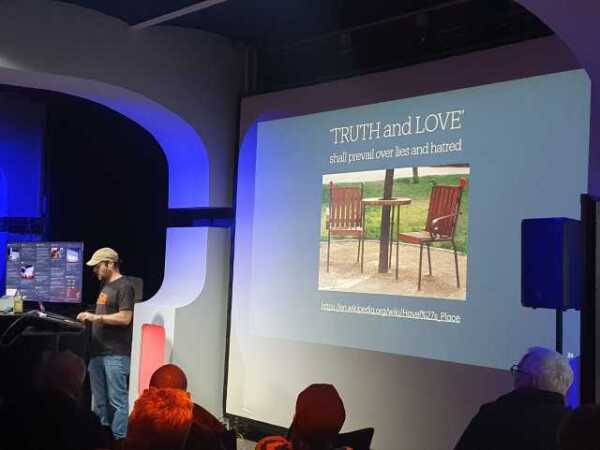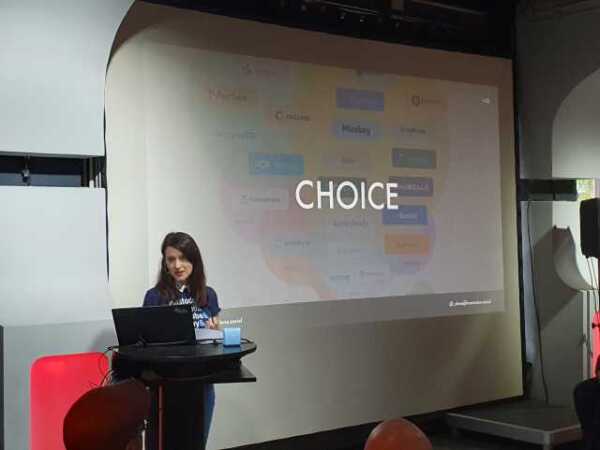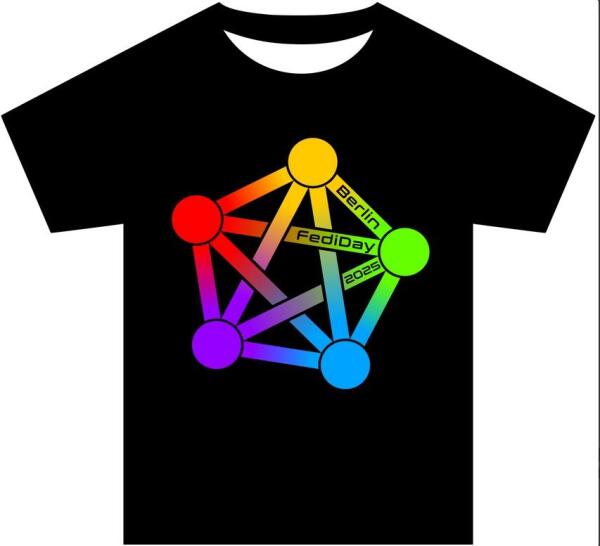Search
Items tagged with: fediverse
Heute war ja der erste #diday und Teil der Idee ist es ja Leute ins #Fediverse zu bekommen. Wir wissen alle, dass das Fediverse groß, unübersichtlich und einschüchternd seit kann.
Eine hervorragende Reihe von Veranstaltungen auf denen man mal "dumme Fragen" stellen kann (keine Bange, die gibt es nicht) firmieren under dem Hashtag #FediTreff - gibt es über ganz Deutschland und die Welt verteilt. Dezentrale Stammtische um über das Fediverse zu schnacken.
Morgen ist es in #Berlin wieder so weit. Da treffen wir uns jeden 1. Montag im Monat auf der @c-base e.V. ab 19 Uhr. Kommt gerne vorbei wenn ihr #NeuHier seit oder jemanden kennt der noch Fragen zum Fediverse klären will, bevor der DiDay im Social Media Bereich angegangen wird.
Here's your chance to see the fediverse platform Bonfire in action (without having to install it or create an account)
Our favorite fedi live streamer, @ozoned is going to be streaming an install and walk through soon (Jan 2 at 8 AM CST).
Add it to your calendars and #JoinIn
https://freestreamers.btfree.org/event/bonfire-install-and-config-livestream
Import Facebook content (pictures) into friendica
!Friendica Support I suggested today on Facebook that people should start using friendica (or, any #fediverse service) instead of Facebook. I was immediately asked:
"What do I do with the 17 years of pictures I have on Facebook?"
I tried to find an answer - hoping that there would be a way similar to the Instagram import feature of pixelfed, but I could not find one.
Is there a way to get all of your content from Facebook imported into friendica? Or do you know of a #fediverse service similar to friendica that has this feature?
Hey #39C3!
Tomorrow, Day 3, 14:00, I will spontaneously be hosting a session in the @cbase Fediverse Assembly on “Lessons from a Public University: Bringing Institutions into the Fediverse” and sharing my experiences from the step-by-step approach at the University of Innsbruck, where we have a Mastodon Instance on our servers, SSO-connected, based on a general strategic approach towards open plattforms.
Happy to see a lot of Fediverse fighters!
https://events.ccc.de/congress/2025/hub/de/event/detail/lessons-from-a-public-university-bringing-institut
![[39c3] Lessons from a Public University: Bringing Institutions into the Fediverse](https://fika.grin.hu/photo/preview/600/554430)
[39c3] Lessons from a Public University: Bringing Institutions into the Fediverse
Was passiert, wenn eine öffentliche Universität beschließt, das Fediverse als Teil eines ganzheitlichen strategischen Ansatzes für die Wissenschaftskommunikation zu nutzen? Ich werde ehrliche Erkenntnisse aus unserer Arbeit an der Universität Inns...39c3
Thank you to those who are helping TROM monthly! Our first goal is to reach 100 monthly donors to kickstart a new video series for TROM, bring back TROMnews and provide 20GB storage space for our Nextcloud install (TROM Files) for everyone.
We have a lot of projects and hundreds, if not thousands of people are using our services.
Everything we do is trade-free. No bullshit.
We need 17 more donors to reach our first goal. If you can help please see https://www.tromsite.com/donate/
Again thank you to everyone who has supported this project for so many years now!
#foss #opensource #tradefree #trade-free #trom #tromsite #volunteer #fedi #fediverse
📺 "Czym jest #Fediverse? Definiowanie wartości i kluczowych wyzwań" [EN] Tommi Marmo @tommi #SFSCON25
https://vimeo.com/showcase/11927245?video=1137385486
Polecam 👍
SFSCON25 - Free Software Conference 2025 on Vimeo
Join the web’s most supportive community of creators and get high-quality tools for hosting, sharing, and streaming videos in gorgeous HD with no ads.vimeo.com
Mit dem letzten merge gibt es bei #Friendica jetzt die Möglichkeit, die 20 neuesten Beiträge eines Kontakts abzurufen. Das ist für mich deswegen interessant, weil ich gerne Beiträge von den Usern anschaue, bevor ich die Kontaktanfragen genehmige. Damit kann ich mir jetzt eben die letzten 20 Beiträge des Users abrufen und ansehen.
Ihr findet die Möglichkeit auf der Kontaktseite:
Danke @Michael 🇺🇦. 👍
#Fediverse
Issue 15321: Fetch the latest posts from contacts by annando · Pull Request #15322 · friendica/friendica
Hubzilla-Workshop
Learn using BigBlueButton, the trusted open-source web conferencing solution that enables seamless virtual collaboration and online learning experiences.campus.ws-12.de
Heute haben wir das Bündnis "@offene_netzwerke und demokratische Öffentlichkeiten. Dezentral, souverän und fürs Gemeinwohl" gelauncht. ✨
@markusreuter war dabei und berichtet dazu:
Es ist mir eine grosse Freude, dass so viele tolle Organisationen dafür an Board sind 🤗 besonderen Dank @digiges
Helft uns unsere Forderungen zum 🇪🇺 "#Gipfel zur digitalen Souveränität" am 18.11. gut hörbar zu machen!

#Fediverse #savesocial #foefed_digitalrechte

Digitale Souveränität: Neues Bündnis fordert mehr Engagement für offene Netzwerke
In der kommenden Woche treffen sich in Berlin die Regierungschefs von Deutschland und Frankreich mit der EU-Kommission zu einem Souveränitätsgipfel.netzpolitik.org
Mastodon character limit is such a weird concept and useless and pointless I can't believe is still there. People who want to say more than a paragraph need to split it into "threads"...insane!
Look:
How the fuck you get to read and interact with a post divided into tens of comments.....
This is silly as fuck people.
If you have no character limit, guess what, you can still make short posts. But not vice-versa.
It is beyond me why this is still a thing in 2025. Artificial limitations.
Man I LOVE Friendica! A proper way to make posts and interact with people. And yet not many are aware of Friendica and how awesome it is.
@Meredith Whittaker you should either move to a Mastodon instance without character limitation or try Friendca. You can even use our node https://social.trom.tf - and that's for anyone else who is bothered by this artificial limitation of Mastodon.
Atlas Demo #1
I'm really pleased with my progress on #Atlas - a social mapping server for the #Fediverse. In about two weeks, we've gone from tooting an 85mph brainstorm on I70 to a fledgling app that lets me annotate any location on the globe, and share it over #ActivityPub
So here's a quick video of where it is right now. You'll see there's still a lot to do before anyone can really use it. But there's enough here for me to ask for your help. I would love to hear what you think of this short video, and to start talking to everyone out there who's interested in making maps on the Fediverse.
-
I'm expecting this kind of street-level annotation to have lots of uses, from groups of friends replicating FourSquare, to communities organizing events, or citizen journalists recording what's going on in their neighborhood.
Please share this with anyone who might benefit from sharing location notes online. It's time for me to start collecting some needs from real-world users.
https://github.com/EmissarySocial/atlas
GitHub - EmissarySocial/atlas: Annotate real-world locations on the Fediverse
Annotate real-world locations on the Fediverse. Contribute to EmissarySocial/atlas development by creating an account on GitHub.GitHub
👋 If you can see this toot you are on the #Fediverse enjoying #BetterSocialMedia
How flippin' awesome is that!?
In one or two sentences, tell me one thing that stands out for you personally, one of the reasons you enjoy being here.
And if you're ok with me using your answer in promotional material to get more people here, add the tag #TellEveryone 📢
Lieber @waldstepper vielen Dank dafür, dass du in den letzten Jahren Pate für den Fediverse Stammtisch auf der @c-base e.V. warst. Ein großer und wichtiger Baustein auch für den Berliner Fediday 👍😎
Die nächste Möglichkeit jungen Menschen, denen der "GenZ" was vom #Fediverse zu erzählen und näher zubringen ist z.B. bei der #LCOY

LCOY Germany
Die Klimakonferenz für junge Menschen. Du willst neue Kontakte knüpfen und spannende Diskussionen führen? Melde dich direkt an!lcoy.de
One oft the key features of the #Fediverse highlighted by @Elena Rossini ⁂ St #fediday in #Berlin
Choice
👥 Joining the team for #FediDay: @tobias and @herr_irrtum are supporting us as co-organizers! 🙌
Together, we’re putting together a strong program all about the Fediverse 🌐✨
#Fediverse
Hi there,
some questions about the behavior of friendica with respect of preserving the content of posts from other servers and other #fediVerse platforms.
There are several options in #friendica to mark posts. There is staring a post or an answer, there is interacting with it like giving a thumbs up or done (like\dislike) and answering, saving to a folder and sharing or resharing a post. Answers can't be stared but saved to a folder, shared and reshared.
What happens when a post or an answer is deleted y the owner of that post or answer?
There are posts from other instances that still are preserved over here even tho they don't exist anymore on the originating server.
What happens if answers are deleted by the owner of the answer? Also, somehow answers to answers are related and they do disappear at least when an answer is deleted locally on this server. Is the same true if an answer is deleted by the originating profile?
Also, have there been changes on the behavior on these aspects in friendica or are their discussion about changing some of those aspects?
Ein langes Wochenende steht vor der Tür... ich erwarte Weltuntergangsstimmung am Donnerstag bei den Wochenendeinkäufen und dann viele interessante Vorträge und Gespräche beim 2. Berliner Fediday auf der c-base

Berliner Fediverse Tag | Berlin Fediverse Tag 2025
Der Berliner Fediverse Tag ist eine am 3-5.10.2025 in der Berliner c-base stattfindende Konferenz zum Fediverse mit Workshops und Vorträgen für Interessierte, Neulinge und alte Hasen.Berlin Fediverse Tag 2025
I not only maintain a list of digital service providers that operate outside U.S. jurisdiction, but also a list of Fediverse sites that use non-U.S. domain extensions.
If these sites also use web hosting outside the United States, their websites could be fully outside U.S. legal reach — which is a smart move. 😉
You can see the list here:
https://codeberg.org/Linux-Is-Best/The_Fediverse_Outside_United_States/src/branch/main/Index.md
#Mastodon #Misskey #PixelFed #PeerTube #CherryPick #Fediverse #ActivityPub #DigitalSovereignty
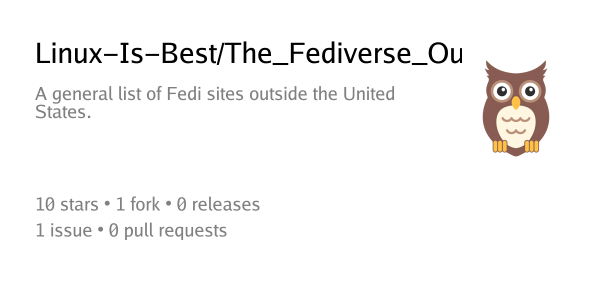
The_Fediverse_Outside_United_States/Index.md at main
The_Fediverse_Outside_United_States - A general list of Fedi sites outside the United States.Codeberg.org
I'm sad to see IFTAS Connect shutting down. #IFTAS offered a community platform for server admins and moderators, committed to keeping the #fediverse safe.
Thanks everyone at @iftas for your hard work. 🫶
https://about.iftas.org/2025/09/29/sunsetting-iftas-connect/
I'm a computer programmer with a Fediverse account, and I am this many years old.
Please consider boosting for a more representative sample.
#programming #poll #demographics #fediverse #age
- 10-20 years old. (1%, 3 votes)
- 21-30. (17%, 42 votes)
- 31-40. (25%, 62 votes)
- 41 or older. (56%, 139 votes)
🚀 Gesucht!
Am Montag, 29.09.2025 um 19:30 Uhr ist wieder Fediverse-Sprechstunde!
🌐 Thema diesmal: Friendica
Da ich selbst v. a. auf Mastodon & Hubzilla unterwegs bin, suche ich Friendica-Nutzer:innen, Instanzbetreiber:innen & Entwickler:innen, die ihre Erfahrungen teilen möchten – gern mit einem Vortrag, Tipps oder praktischen Hinweisen.
In unserer Fediverse-Sprechstunde möchten wir nach und nach alle Anwendungen aus der vielfältigen Welt des Fediverse vorstellen und bekannter machen.
Ich selbst habe viele Fragen zu Friendica – und sicher geht es anderen ähnlich.
👉 Wer Lust hat, die Fediverse-Sprechstunde aktiv mitzugestalten, darf sich gern bei mir melden!
#Fediverse #Friendica #Mastodon #Sprechstunde #FediverseSprechstunde
🚨 Letzte Chance! 🔥
Der #Fediday-Merch ist noch bis Freitag Mittag bestellbar! 🕛
Sichert euch jetzt T-Shirts & Zipper – solange der Vorrat reicht! 👕🧥
📸 Checkt die Fotos ab – sehen mega aus! 😍
➡️ Jetzt bestellen und ready für den Fediday sein! 🎉 https://ctix.c-base.org/fediday/2025/
Hello Fediverse I want to make a short announcement about the https://social.trom.tf Friendica instance run by my friend @tio
Currently that instance is going through a big server migration process and it will take a couple of hours for it to get finished. So if you mention or send anyone messages during this time it might not reach them.
@Hypolite Petovan
Actually I think #Fediverse admins should definitely talk about what measures to take in terms of moderation and federation as long as someone is suggesting blocking whole instance for one post, that was moderated.
Common moderation process on #Czech instances is:
1. Delete post, notify user
2. If violated again, block the user
3. (not always) admins warn themselves if violator registers on different instance
In my point of view blocking whole instance is overreaction as long as it's easy to just defederate rule violator.
In my point of view you defederate instances where bad stuff is tolerated, not instances, where it's moderated - that does not make sense and even though it is meant to be just a recommendation this can make instance appear on some sort of block list between csam and nazis, where nobody checks url after url if they actually are problematic.
I consider this more dangerous than one (moderated) post





